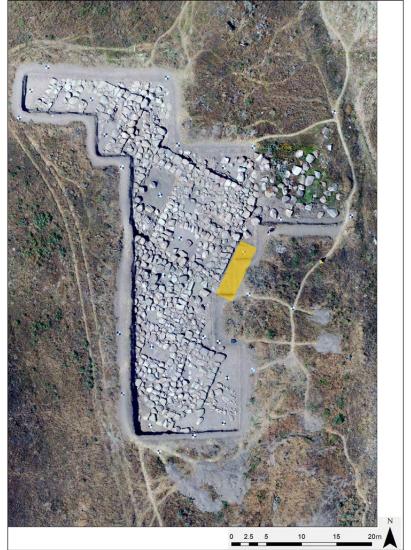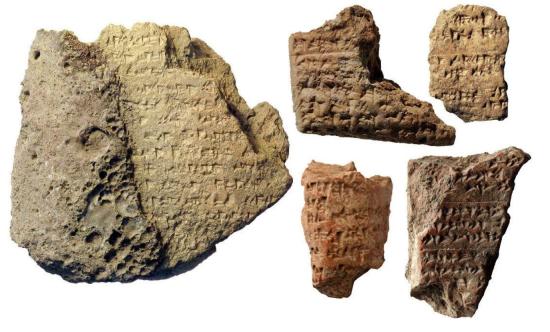Intricate stone floor by a possible temple and cuneiform texts indicate that Usakli Hoyuk may have been the lost Hittite city of Zippalanda, suggests archaeologist Anacleto D’Agostino
Ruth Schuster
Source - https://www.haaretz.com/archaeology/.premium.MAGAZINE-earliest-mosaic-in-the-world-found-in-turkey-1.8435728
A crude tiled floor laid down in geometric patterns, unearthed in a preclassical Hittite town in central Turkey, is the earliest-known mosaic in the world, reports Anacleto D’Agostino of the University of Pisa. Moreover, he adds, the settlement where the mosaic was found may be the lost Hittite city of Zippalanda.
Discovered during the excavation of prehistoric Usakli Hoyuk, the multichromatic patterned surface is in the courtyard of a public building – which archaeologists interpret to be a temple to the Storm God, D’Agostino writes in Antiquity, published by the Cambridge University Press. Made of stones of varying size and shape, the Late Bronze Age floor is also the earliest-known rendition in rock of geometric patterns.
The later mosaics that most people are more familiar with are “pebble mosaics” made of unworked small, round stones, or tile mosaics made of small, flattened cubic or rectangular tiles.

Side view of the Usa̧klı tell - Usa̧klı Höyük Archaeological Project
In contrast, the Usakli mosaic consists of 3,147 pieces of irregularly shaped stones, plus the odd pebble. The part exposed so far measures about 3 by 7 meters (10 by 23 feet) in area, D’Agostino writes.

Aerial photo, showing the postulated Storm God temple: the site of the mosaic is highlighted in yellow - Usa kl Hyk Archaeologica
All the stones were laid flat, not quite touching one another, and formed geometric patterns in contrasting dark and light colors. The mosaic consists of three rectangular frames, each containing three rows of triangles of different colors, mainly white, light red and blue-black. Two stones are orange-yellow, D’Agostino notes. The mosaic was framed with perpendicularly positioned stones in white, black-blue and white again.
The mosaic and eastern wall of the building interpreted as a Storm God temple do not touch one another but have the same orientation, D’Agostino states: the mosaic’s frame runs precisely parallel to the wall. These two Bronze Age edifices are clearly contemporaneous, he concludes. Also, the building and mosaic are characterized by “high status architecture,” while later remains in the town (from the end of the Bronze and Iron ages) are not, lending to the theory that this town was Zippalanda – and therefore the temple would have been to the Storm God.
The stones comprising this earliest-known mosaic floor vary in size and shape. One wonders how comfortable it was to walk on and one envisions a lot of twisted ankles.
D’Agostino enlightens that, first of all, the face of the stones is roughly flat or slightly rounded, not unlike paving stones used in the streets of many medieval and post-medieval European cities and villages. Second: Considering the environmental conditions on the Anatolian plateau, if anything the stones could have saved a lot of ankles by channeling the rainwater and preventing the formation of slippery mud on the floor, he suggests.

Closeup of the mosaic at Usakli Hoyuk.- Anacleto D'Agostino
Hittites typically paved their streets and the courtyards of public buildings, which, given the local clime in Anatolia, could well have been an adaptation to precipitation – though some inner rooms were also paved, he adds. Who knows: Maybe their footwear made of leather, wool and other organic materials was appropriate and could get a good grip on stones and grass growing in the interstices between them.

Cuneiform texts found at Usa̧klı Höyük - Usa̧klı Höyük Archaeological Project
He adds that the floor may give the impression today of being hard to walk on because it was disturbed and disarticulated by post-depositional events. “Thousands of years below the topsoil and later human activities can do that,” he points out to Haaretz.
Stone Age towns in Turkey
Intense occupation of Usakli Hoyuk began at least 5,000 years ago, the time of the Bronze Age, though some sporadic pottery sherds have been found from an even earlier time, the Chalcolithic. It had its heyday during the time of the Hittite Empire, between 4,000 to 3,000 years ago.
There are older towns than Usakli Hoyuk in central and southern Turkey. A study published in Nature Communications last year, and work by Prof. Israel Hershkovitz of Tel Aviv University, all posit that subsistence agriculture began well over 10,000 years ago in Anatolia, possibly with prehistoric Iran involved too. In any case, hunting-gathering slowly and fitfully gave way to subsistence agriculture over millennia, and southern Turkey has a number of settlements that probably arose during this transition period.
The most famed of the Late Stone Age sites is Gobekli Tepe, home of the “first temple in the world.” Dating to around 11,500 to 12,000 years ago, a pre-agricultural time, Gobekli’s monumental architecture has flummoxed theoreticians who assumed hunter-gatherers were small groups of nomads who couldn’t get organized to the degree necessary to produce monumental construction. So either they could, or subsistence farming began earlier than we think, or there is some other truth involved.
Other studies have shown that the good people of Catalhoyuk, a 9,000-year-old town also in south-central Turkey, grew grain and ate domesticated animals. The prevalence of signs of violence on their bones indicates that these early townsfolk couldn’t bear each other – but that’s a different story.
Perhaps by the time Usakli Hoyuk arose a couple of thousand years later, people had learned how to get along.
Certainly by then they had an appreciation of the divine. As mentioned, D’Agostino thinks Usakli Hoyuk may have been the legendary city of Zippalanda – and has multiple grounds to make this argument.
Praying to the Storm God
Usakli Hoyuk was a mere two-day walk from the Hittite capital of Hattusa, and contains the ruins of a building whose architectural plan and stonework are typical of Hittite public buildings, D’Agostino explains. He thinks this building, most of whose stones were scavenged over the ages, was likely the Storm God temple.
The Storm God (or storm god) was a common, eminent deity among different populations, starting from the third millennium B.C.E., D’Agostino tells Haaretz. “He was one of the most important gods in the Near Eastern pantheon, worshipped under different names throughout Anatolia, Levant, Syria, Mesopotamia, also in Cyprus for example, and in other regions around the Mediterranean Sea.” There is even a theory that a storm god lay behind the earliest conceptualization of the Jewish god YHWH.
Also, fragments of cuneiform tablets found on the slopes of the Usakli tell suggest the importance of the settlement at the time of the Hittite Empire.
“This is still hypothetical and awaits final proof, but the position of the site, its size, and the discovery of the large public buildings together with the presence of cuneiform texts of various content, support the proposed identification of Usakli with the Hittite holy city of Zippalanda – an important center of the cult of the Storm God,” he tells Haaretz.
Then there’s that mountain looming south of the city.
Usakli Hoyuk is mentioned in the “An-tah-Sum” Hittite text, about a spring-related festival, though exactly what it hails remains unclear. Some scholars think tah-sum stems from the Sumerian word for crocus, and that the festival was designed to fete and appease the sun and storm gods: spring is a time of uneven weather.
The An-tah-Sum text relates the journey of the Hittite king from Hattusa (the capital) to Zippalanda, and from there to Mount Daha. There, the monarch performs a rite before continuing on to the city of Ankuwa, identified with the site of Alisar Hoyuk.
Usakli Hoyuk lies halfway between Alisar Hoyuk and Hattusa, and the imposing mount known as Kerkenes Dag, which to the town’s south, corresponds exactly with the position of Mount Daha based on the ancient written sources.
Most Hittitologists agree to this proposed identification of the mountain, D’Agostino tells Haaretz. He even postulates that the triangles in the mosaic may be a reference to the image of the mountain.
Stone flooring has been associated with a number of Hittite temples in Anatolia: D’Agostino lists several, including the Greta Temple of Sarissa – but they were basically crude pebble flooring, not decorative.
“The floor of Usakli is unique in that it comprises smaller stones carefully chosen for their shape and color to allow the creation of geometric designs in specific colors,” he explains.
During the Iron Age, multicolored pebble mosaics sprang up widely in Anatolia itself, and in Syria and Mesopotamia. The earliest known of that later lot is in the so-called “burned building” (the Levant has a lot of those) in the citadel of Gordion, the royal city of King Midas, in central Turkey. The city, which would become the monumental capital of the Phrygians, was founded at least 6,000 years ago, went through a Hittite period of its own featuring a gorgeous, finely made pebble mosaic, and was one of the very many cities in the region that got burned down.
In any case, the mosaic floor now reported in Usakli is older. “As the earliest polychrome, geometric mosaic stone floor, the Usakli Hoyuk pavement could represent a Late Bronze Age Anatolian forerunner for layers of polychromatic mosaic floors,” D’Agostino concludes.
It is true that the next early mosaics of the Phrygians and Syro-Hittites were more complex or checkerboard in pattern. “In fact, the Phrygian specimens have very complex patterns, asymmetrical and with very weird motifs,” he shares with Haaretz. But then style does change over the centuries and millennia.